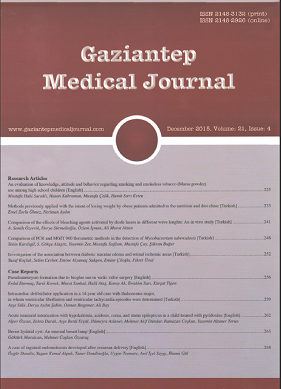Acute isoniazid intoxication with hypokalemia, acidosis, coma, and status epilepticus in a child treated with pyridoxine
DOI:
https://doi.org/10.5578/GMJ.10811Keywords:
Child, coma, isoniazid, status epilepticus, pyridoxineAbstract
Isoniazid intoxication can cause refractory seizures, metabolic acidosis, rhabdomyolysis, coma, and even death. We report a case of acute isoniazid intoxication presenting with hypokalemia, acidosis, coma, status epilepticus, and pyridoxine treatment. A previously healthy 13-year-old Turkish girl presented to our hospital due to vomiting and generalized tonic -clonic seizures that started two hours after ingesting 15 tablets of 300 mg isoniazid (80 mg/kg) for the purpose of suicide. On laboratory examination, metabolic acidosis, hypokalemia and elevated transaminase, creatine phosphokinase (CPK) were detected. Five gram of pyridoxine was infused in 500 mL of 10% dextrose over 30 minutes. In follow-up, no hepatic and renal failure was found. We describe A child who presented with status epilepticus and coma after taking overdose of isoniazid in this study. When isoniazid is taken in high doses, pyridoxine depletion occurs, which results in siezures. We would like to emphasize that intravenous pyridoxin should be administered as soon as possible in isoniazid intoxications.
Metrics
References
Olson KR, Kearney TE, Dyer JE, Benowitz NL, Blanc PD. Seizures associated with poisoning and drug overdose. Am J Emerg Med 1994;12(3):392-5.
Cash JM, Zawada ET Jr. Isoniazid overdose. Successful treatment with pyridoxine and hemodialysis. West J Med 1991;155(6):644-6.
Modi S, Buff AM, Lawson CJ, Lawson CJ, Rodriquez D, Kirking HL, et al. Reporting patterns and characteristic of tuberculosis among in international travelers, United States, June 2006 to May 2008. Clin Infect Dis 2009;49(6):885-91.
Özçetin M, Yılmaz R, Karaaslan E, Bekar Ü, Yerli Y, Köseoğlu D. Tüberkülozun nadir birşekli: tekbaşına psoas apsesi. Türk Pediatri Arşivi 2011;46(4):340-2.
Saukkonen JJ, Cohn DL, Jasmer RM, Schenker S, Jereb JA, Nolan CM, et al. An offi cial ATS statement: hepatotoxicity of antituberculosis therapy. Am J Respir Crit Care Med 2006;174(8):935-52.
Romero JA, Kuczler FJ Jr. Isoniazid overdose: recognition and management. Am Fam Physician 1998;57(4):749-52.
Tibussek D, Mayatepek E, Distelmaier F, Rosenbaum T. Status epilepticus due to attempted suicide with isoniazid. Eur J Pediatr 2006;165(2):136-7.
Sridhar A, Sandeep Y, Krishnakishore C, Sriramnaveen P, Manjusha Y, Sivakumar V. Fatal poisoning by isoniazid and rifampicin. Indian J Nephrol 2012;22(5):385-7.
Uzman S, Uludağ Yanaral T, Toptaş M, Koç A, Taş A, Bican G. Acute isoniazid intoxication: an uncommon cause of convulsion, coma and acidosis. Tuberk Toraks 2013;61(1):50-3.
Lheureux P, Penaloza A, Gris M. Pyridoxine in clinical toxicology: a review. Eur J Emerg Med 2005;12(2):78-85.
Downloads
Published
How to Cite
Issue
Section
License
Copyright (c) 2023 European Journal of Therapeutics

This work is licensed under a Creative Commons Attribution-NonCommercial 4.0 International License.
The content of this journal is licensed under a Creative Commons Attribution-NonCommercial 4.0 International License.


















